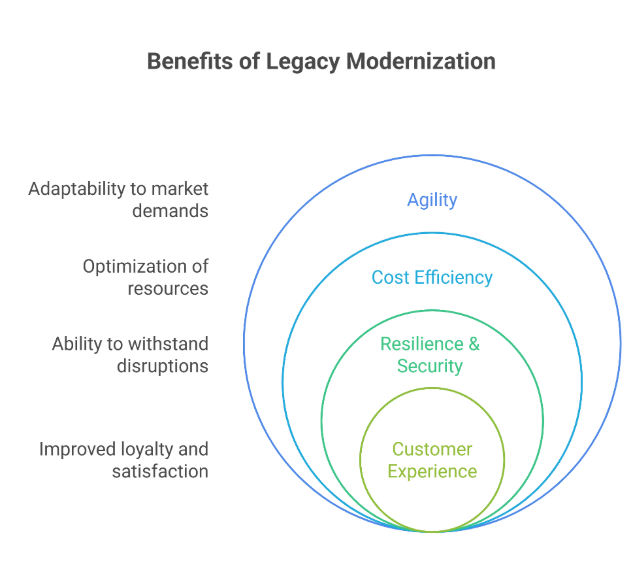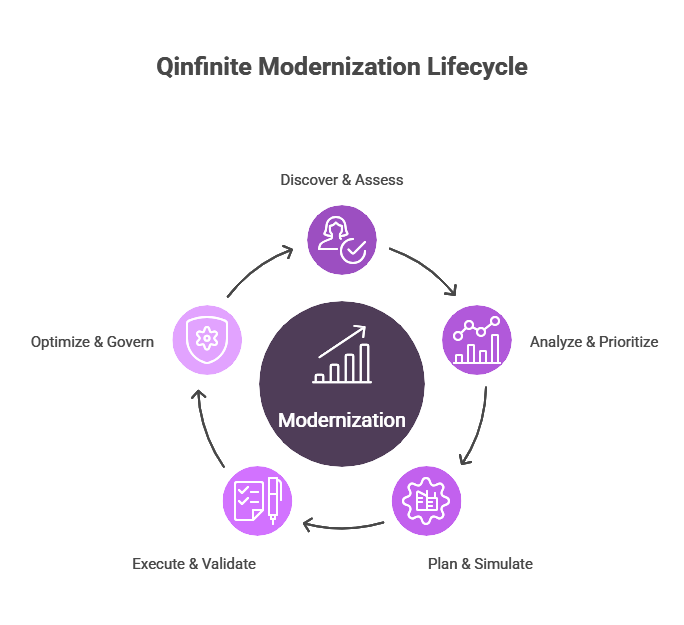Accelerate IT operations with AI-driven Automation
Automation in IT operations enable agility, resilience, and operational excellence, paving the way for organizations to adapt swiftly to changing environments, deliver superior services, and achieve sustainable success in today's dynamic digital landscape.
Driving Innovation with Next-gen Application Management
Next-generation application management fueled by AIOps is revolutionizing how organizations monitor performance, modernize applications, and manage the entire application lifecycle.
AI-powered Analytics: Transforming Data into Actionable Insights
AIOps and analytics foster a culture of continuous improvement by providing organizations with actionable intelligence to optimize workflows, enhance service quality, and align IT operations with business goals.
Legacy systems often sit at the heart of an enterprise’s IT stack. They keep the business running, but over time, they become fragile, costly to maintain, and resistant to change. For CIOs and technology leaders, the dilemma is: how do you keep the business stable while embracing modernization?
At Quinnox, we’ve seen this challenge repeatedly across industries, from banking to manufacturing to retail. With Qinfinite, our AI-powered Intelligent Application Management (iAM) platform, we help organizations transform outdated systems into future-ready IT applications without disruption.
In this blog, we’ll explore what legacy systems are, why modernization is critical, the strategies we use, and five real-world examples that demonstrate tangible outcomes.
What Are Legacy Systems?
Legacy systems are outdated applications or infrastructure that still support critical business processes but rely on old technologies like COBOL, mainframes, or custom ERP. They’re hard to integrate, expensive to maintain, and risky to scale. Many organizations still rely on these systems because they perform essential functions, contain decades of valuable business data, or are too costly or risky to replace without careful planning.
Why Modernize Legacy Systems?
Modernization aims to upgrade legacy systems to improve performance, enhance security, reduce maintenance costs, and enable innovation. This is often achieved by leveraging cloud computing, microservices, APIs, and modern development frameworks. Here are the main reasons why modernizing legacy systems is a necessity –
- Agility: Legacy IT slows innovation; modernization enables faster releases and digital transformation.
- Cost Efficiency: Outdated systems consume a disproportionate share of IT budgets.
- Resilience & Security: Modern architectures reduce downtime and improve compliance.
- Customer Experience: Users expect seamless, digital-first interactions that legacy systems can’t deliver.

Transforming outdated software, systems, or technology stacks means more than just rewriting code, it’s about reimagining them into agile, scalable, and future-ready digital solutions. The goal of legacy modernization is to ensure your systems not only keep pace with the latest technology but thrive in today’s digital-first world.
Gartner estimates that 40% of enterprise systems are well past their end-of-life, no longer supported by vendors, and dangerously brittle, leading to operational inefficiencies and technical debt.
Real Examples of Legacy System Modernization
Here are five examples showing how modernization turned challenges into measurable business outcomes:
1. High-Tech Manufacturing: Avoiding $10M Costs with Auto Optimize
In the world of high-tech manufacturing, even a few minutes of downtime can cascade into millions in lost productivity, delayed shipments, and strained customer relationships.
One U.S.-based manufacturer found itself at a crossroads. Its IT infrastructure was struggling to keep up with rapid growth and rising customer demand. An external assessment vendor had reviewed their system and recommended a drastic increase in infrastructure capacity, up to 60% to handle projected future loads. The estimated cost of this was about $10 million.
Solution: Quinnox stepped in with a recommendation to adopt a Qinfinite-powered solution. The proposed strategy was to maintain the base capacity on-premises for core operations and to leverage cloud solutions for scalable needs. This hybrid approach was designed to optimize costs while ensuring the flexibility to scale operations dynamically.
Results:
Cost Savings: The predictive scaling allowed the company to avoid the proposed $10 million expenditure, significantly reducing their operational costs.
High Availability: With real-time adjustments and predictive resource allocation, system availability remained at a stellar 99.999%, crucial for their 24/7 manufacturing operations.
Scalability and Flexibility: The hybrid model provided the flexibility to scale up resources during product launches and high-demand periods without permanent investment in infrastructure.
2. European Bank: AI-Powered ITSM for Faster Resolution
In today’s fast-moving financial sector, customer trust hinges on seamless digital services. Amid mounting regulatory scrutiny and rising competitive pressure, a major European bank found its IT support overwhelmed, grappling with thousands of routine incident tickets every month.
The volume of manual work slowed response times, frustrated users, and strained staff capacity. Rather than scaling headcount, the bank sought a smarter and more efficient solution.
Solution: Without disrupting existing tools or processes (ServiceNow, Slack, Confluence), Qinfinite was implemented as an overlay AI-powered agent to drive intelligent automation across the service desk.
Results:
- 90% MTTR reduction
- 80% less L1 manual effort
- 2x ticket handling capacity without new hires
- Stronger compliance and user satisfaction
3. Manufacturing: Event Intelligence Reduces Alert Fatigue
In a large, complex manufacturing environment, spanning on-prem, cloud, and hybrid systems, the IT team was drowning in event noise. Every day, thousands of alerts poured in, triggering alert fatigue. The chaos made it nearly impossible to prioritize critical issues, correlate root causes, and resolve incidents in time. As a result, production faced lengthy downtime, eroding customer satisfaction and operational efficiency.
Solution: Qinfinite’s Event Intelligence overlay was deployed to transform alert management. It used AI for event correlation, synthetic monitoring, and automated remediation, all orchestrated across multiple domains and systems.
Results:
- 70% fewer alerts
- 60% faster MTTR
- 50% fewer incidents
- 40% higher uptime
- 30% improved customer satisfaction
4. Bottling Manufacturer: Chaos Engineering for Resilience
In one of the world’s most expansive bottling operations, managing 54 brands, 1.7 million customers, and nearly 33,000 employees, system failures during peak production were triggering delays, eroding customer trust, and cutting into revenue.
Their supply chain management system consists of various discrete systems including ERP, home grown application, SaaS and B2B systems. They faced difficulties identifying the root causes of these failures and optimizing system performance to ensure uninterrupted production.
Solution: Qinfinite Chaos Engineering injected controlled failures such as API lag, cache timeouts, network latency, B2B exchange disruptions, and database slowdowns, into the production environment to surface hidden vulnerabilities.
Results:
- 70% fewer failures in peak operations
- 30% higher throughput
- Stronger resilience across mission-critical systems
5. BFSI Client: IT Operations Transformation
A prominent U.S.-based financial-services institution was stretched thin, its support team was grappling with a 16% workload overrun, juggling both .NET and mainframe environments.
The pressure to extend support to 24×7 was rising, but without added staffing. In addition, knowledge attrition and inadequate visibility into system dependencies were dragging down responsiveness and decision-making.
Solution: The bank adopted Qinfinite, starting with a full-scale discovery phase that built a Knowledge Graph mapping their IT infrastructure, business processes, and stakeholder roles. This enabled intelligent incident analytics, automated remediation of repetitive tasks, and real-time operational visibility via BizOps dashboards.
Results:
- Reduced IT costs
- Streamlined support operations
- Faster, data-driven insights across the enterprise
How We Modernize These Legacy Systems
Qinfinite employs a systematic and intelligent approach to breathe new life into legacy systems. Our modernization lifecycle is designed to minimize risk, maximize value, and ensure sustainable transformation through five key phases:

1. Discover & Assess – Automated Discovery with Knowledge Graphs
The first step in modernizing legacy systems is to gain a comprehensive understanding of the existing environment. Qinfinite leverages automated discovery tools that integrate Knowledge Graphs to map out the entire IT landscape. These Knowledge Graphs create interconnected data models representing applications, services, dependencies, and infrastructure components.
By automatically identifying relationships and data flows, we create a dynamic and precise inventory of your legacy assets. This rich, contextual understanding not only reveals hidden technical debts but also uncovers opportunities for improvement that manual audits might miss. The result is a detailed, data-driven snapshot of the legacy ecosystem, ready to inform strategic decisions.
2. Analyze & Prioritize – Business Impact-Driven Modernization Roadmap
Modernization efforts are most effective when they align tightly with business goals. Qinfinite moves beyond just technical assessment by analyzing the business impact of each legacy component. We evaluate criticality, user dependencies, risk factors, and potential benefits to the organization. This allows us to prioritize modernization targets based on their contribution to business value rather than solely technical complexity.
The outcome is a tailored roadmap that balances quick wins with longer-term strategic goals, ensuring that investments deliver measurable business outcomes. This roadmap becomes the north star guiding all subsequent modernization activities.
3. Plan & Simulate – Digital Twin Modeling to De-Risk Execution
To mitigate the risks associated with transforming mission-critical systems, Qinfinite introduces digital twin modeling – a virtual replica of the legacy system and its environment. This digital twin allows us to simulate changes, migrations, and upgrades in a controlled setting before touching the live system. By running scenarios such as workload shifts, integration points, or failover processes on the digital twin, we uncover potential issues, resource bottlenecks, and performance impacts ahead of time. This proactive simulation ensures the modernization plan is both feasible and optimized, significantly reducing downtime and unforeseen errors during execution.
4. Execute & Validate – AI-Driven Automation, Chaos Engineering, Validation
The execution phase is powered by advanced AI-driven automation tools that accelerate code migration, refactoring, and infrastructure provisioning while maintaining strict governance. To ensure system resilience, Qinfinite integrates chaos engineering practices intentionally injecting failures to test robustness and recovery mechanisms. This approach verifies that the modernized system can withstand real-world stresses and maintain continuous service.
In addition, our comprehensive validation steps, including functional tests, performance benchmarks, and compliance checks, confirm that each modernization milestone meets quality and security standards. This combination of automation and rigorous validation guarantees a smooth transition with minimal business disruption.
5. Optimize & Govern – Continuous Optimization and Intelligent Incident Management
Modernization is not a one-time event but a continuous journey. Post-deployment, Qinfinite implements intelligent monitoring and governance frameworks that use machine learning to analyze system performance and detect anomalies in real-time. This proactive stance enables rapid incident identification and resolution before they impact users.
Furthermore, continuous optimization cycles refine resource utilization, enhance scalability, and adapt to evolving business needs. Through a combination of automation, analytics, and governance, Qinfinite ensures that modernized legacy systems remain agile, efficient, and secure long after the initial transformation is complete.
Conclusion
The five real-world examples we’ve explored prove that with the right strategy, tools, and expertise, even the most complex legacy environments can be transformed into modern, high-performing systems that drive tangible business outcomes – from cost savings and improved performance to enhanced customer experiences and greater scalability.
However, successful modernization doesn’t happen by accident. It requires a structured approach, deep technical insight, and a clear alignment with business goals. That’s where Qinfinite comes in.
Our experts specialize in transforming legacy systems into future-ready platforms using a proven modernization lifecycle. Whether you’re looking to reduce technical debt, enable cloud adoption, or unlock innovation trapped in outdated systems, we help you do it with confidence, speed, and minimal risk with our AI-powered legacy modernization services.
Ready to take the first step toward unlocking the full potential of your legacy systems? Reach our Qinfinite experts today!
FAQs
An outdated IT system that is costly to maintain, hard to scale, and often runs on obsolete technology.
Full replacement is risky and expensive; modernization balances continuity with transformation.
Anywhere from weeks to months, depending on system complexity and scope.
AI powers automated discovery, predictive insights, incident resolution, and risk simulations.
Banking, insurance, manufacturing, retail, logistics, and public sector—industries where legacy IT is mission-critical.